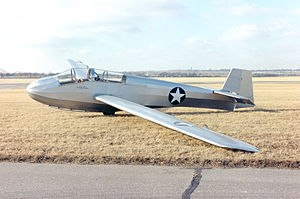Schweizer SGS 2-12
| SGS 2-12, TG-3 | |
|---|---|
 |
|
| TG-3A preserved at the National Museum of the United States Air Force | |
| Role | Training sailplane |
| National origin | United States |
| Manufacturer | Schweizer Aircraft Corporation |
| Designer | Ernest and Paul A Schweizer |
| First flight | 1942 |
| Number built | 114 |
The Schweizer SGS 2-12 is a United States two-seat, low-wing, training glider built by Schweizer Aircraft of Elmira, New York.
The 2-12 was a development of the Schweizer 2-8 two place training glider, with an all-wooden wing. It was designed especially for a US Army Air Force requirement to train glider pilots for air assault missions in World War II.
When the US entered World War Two in 1941 none of the US services had a glider program. The German use of glider-borne attack on the Belgian fortress of Eben-Emael and their use in the Battle of Crete convinced the US military that they would need glider-borne forces of their own.
Initially the USAAF contracted Schweizer for the construction of the existing SGS 2-8, which entered service as the Army TG-2 and the US Navy and US Marine Corps LNS-1. The 2-8 was a good glider trainer, but had fabric-covered aluminum wings. Aluminum was designated as a "strategic material" and its use was to be avoided in training aircraft to conserve it for combat aircraft. Schweizer was therefore asked to design a new glider that would not use aluminum.
Work began on the new model SGS 2-12 in the winter of 1941/42 as production of the 2-8 was getting under way.
The 2-12 had a wooden wing, replacing the aluminum wing on the 2-8. Since the wing was being redesigned, several other improvements requested by the USAAF were incorporated into the design, including simplifying the design for mass production.
The new wing was 2 feet greater in span, giving it a slightly better glide ratio than the 2-8. The greater span also helped make up for the additional weight of the aircraft. Typical empty weights were almost double that of the 2-8 at 860 lbs (390 kg).
The wing was also thicker in section, with a thicker spar, which allowed the elimination of the struts that the 2-8 had used, while permitting a higher redline speed. The wing was also moved from a mid-wing position to a low-wing, to improve the instructor's visibility from the rear cockpit. The new wing also incorporated balanced top and bottom surface divebrakes, replacing the 2-8's top surface spoilers.
...
Wikipedia
